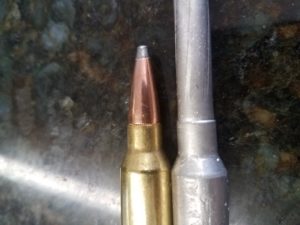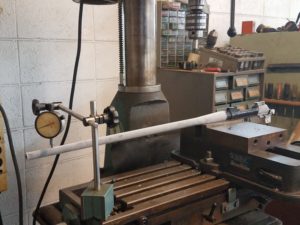It brand new and shoots 3 inch groups at 100 yards.
It shows up a lot in September. They got a new gun and went to the range to sight in and it doesn’t shoot well. Maybe they have an unrealistic idea that all guns shoot in one hole or should. As the gunsmith you will have to do a little detective work before you start chasing down the problem. First see if you can isolate the problem to one area.
- The shooter- Ask how they shot the gun. Off a bench? Sand bags? truck hood? Distance? Have they shot before? Have they ever shot a small group? Do they have another rifle that shoots well? Most deer hunters don’t practice and have little experience shooting. The average hunter sights in with less than 10 rounds and then fires 5 to 10 rounds during the year. Contrast that with a high-power competitor that shoots 3000 aimed rounds a year and you realize your customers will vary in experience and capability.
- The ammo- always surprised how many people think a good gun will shoot bad ammo. Its more like a race car. Good guns are built to use the best ammo and might even shoot bad ammo worse than a clunker. Most guns will shoot some loads better than others. It is always best to let the gun tell you what it wants to shoot instead of you trying to make it shoot what you want. No I don’t like load sensitive rifles but that doesn’t mean I don’t have to live with them. Factory ammo is much better than it use to be. Yes there is some bad stuff on the market but you will basically get what you pay for. I usually have a standard test load for each caliber. It might not be the best load for that particular gun but it will usually be good enough that I will know that if it wont shoot my test load something is wrong. Example- Federal Gold medal Match for 308 loaded with 168 Match Kings. If it wont shoot that then something is wrong!
- Optics- Let me just say this first. I hate scopes. They can make your life miserable. I can find the flaw in the barrel, action or bolt but you are always guessing with the scope. Use your bore-sighter and turn the adjustments both ways while tracking the movement of the reticle. It should be smooth and reverse direction without backlash. It should be close to the center of movement. Scopes don’t work well at the end of adjustment. Check all the screws in the base and rings. If they were put on with thread locker then you need to understand that the screw might be tight but the base can be loose. The tightness you feel is not the head of the screw pushing against the base. It is the threads locked. If all checks good and you still suspect the scope use a known good scope for a test. I didn’t say a new scope or another scope.
- Barrel- Look first down the outside while holding it up to a light. The light reflected along the outside will show a bulge. Inspect inside with a borescope if you have one. Check the headspace. Pay close attention to the throat. That is the short section in front of the chamber where the bullet first hits the rifling. If the throat is crooked or damaged (and a lot are) the bullet will be pushed off center when it enters the rifling and accuracy will suffer. I make a chamber cast with cerrosafe from Brownells. It is reusable and melts in boiling water. Nothing else will show you the throat as clearly. Clean the bore and then push a tight oiled patch down the bore while feeling the resistance. If it has a loose section it will never group. Slug the bore to confirm.

Cartridge and cast of the chamber Notice how short the throat is. This is a factory 300 win mag. Look where the rifling starts on each groove. If it starts at the same place all the way around that is a good throat.
If the is nothing else apparent I will freeze a barrel and then watch the barrel return to room temperature to see if the barrel is warping during temperature change. Just put the barreled action in the freezer overnight and then clamp it in your milling vise with a dial indicator on the muzzle. Don’t touch it and let it warm to room temp. If the bore is off center it will be a banana.

freeze test - Bedding- What you want bedding to do is cradle the action without putting stress on the action that will shift during firing. While target guns are designed to float the barrel most factory guns will allow the barrel to push against the forearm. If the action isn’t bedded it will probably be better left with some upward pressure. Use your bore sighter again (collimator) and look through the scope. push on the side of the barrel and make sure it returns to the same position. Then tighten and loosen the guard screws and look for movement. If the barrel or action can move and stay in more than one place that is a problem.
Accuracy problems can be challenging but having a system and a lot of time and effort will give results. The problem for the gunsmith will be getting paid for his work! Knowing gunsmithing and making money don’t always go hand in hand.
